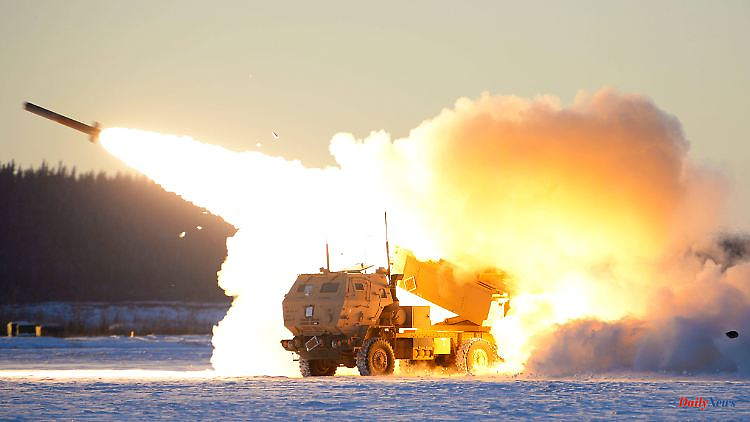The United States has increased its military budget. The Pentagon's planned arms orders show that there is more at stake than just the war in Ukraine.
No, he is said not to have been enthusiastic about the idea of supplying the M1 Abrams main battle tank to Ukraine. But US President Joe Biden could not resist the constant pleas from Kyiv, even before his own Congress. There, Ukraine's President Volodymyr Zelenskyy personally asked for more firepower on the battlefields of his homeland. In addition, there was presumably a request from Berlin not to let go of the Leopard 2 tanks from Germany and other NATO allies alone.
At the last meeting of the Ukraine Contact Group in Ramstein, Rhineland-Palatinate, US Army Chief Mark Milley said there were two military goals. First, to stop the expected offensive by the Russian invading forces. And secondly, at best, to couple this with one's own attack starting in the spring. An attack that the US wants to coordinate with Ukrainian forces. But time is short. Ukrainian soldiers must be trained on the tanks and be ready for action in time.
The United States has been supporting Ukraine since 2014. They are in the lead in helping allies and have repeatedly assured Ukraine that they will stand by Ukraine without ifs or buts. Biden sees the war as a systemic key conflict between democracies and autocracies. He has made winning this global struggle the most important foreign policy task of his presidency. This is reflected in numbers - especially militarily.
Congress supports his plan and last month passed an $858 billion defense budget for this year. That is almost $70 billion more than in 2022. There is also additional aid for Ukraine, which Congress has also approved. The acute reason is the war in Ukraine. The perspective of the competition with China. For context: Germany's entire annual budget for 2023 is set at 476 billion euros.
The parliamentarians also gave the US Department of Defense emergency powers: Because of the war in Ukraine, the Pentagon will be able to order its ammunition and war equipment at short notice over the next two years as needed. The scheme aims to replenish stocks of existing weapon systems and ammunition that have been delivered to Ukraine. But it shouldn't stop there.
The approved orders far exceed the arms left to Kyiv so far. They are armor for the future. Most of what Congress wants can only be delivered many years from now, writes the Washington Post. Accordingly, 700 rocket launcher systems of the HIMARS type are to be purchased. So far, 20 have gone to Ukraine. 106,000 rockets are to be ordered as ammunition for this, 5,000 have been given to Kyiv. And 28,300 new Javelin-type rocket-propelled grenades stand in contrast to 8,500 that have been brought to Ukraine. Because of the course of the war there, the consumption of artillery ammunition is higher than expected, writes the Washington Post.
"Stable front lines, increasingly effective attack chains and less importance of air superiority: The war in Ukraine has become an artillery war," writes the Center for Strategic and International Studies (CSIS) in a recent analysis. No other country has supplied more artillery to the Ukrainian armed forces than the United States.
But Ukraine would need even more, since it must gradually replace its own Soviet-era guns - there is hardly any ammunition left for this, since Russia and China are no longer producers. The supply of ammunition for the US artillery is also shrinking. According to CSIS, Ukraine burns more per day than the US produces in a month. However, US Army Chief Milley says it is unlikely that either side will emerge victorious from the war this year. Despite Ukraine's planned spring offensive. Despite the increased support from allies and the delivery of heavy main battle tanks.
In the explanation of the US military budget, China is a main topic alongside Ukraine. Its build-up to become a regional military power and Beijing's threats to ally Taiwan have also prompted Congress to ramp up spending -- to more than the Pentagon had announced it needed. They now account for 3.74 percent of gross domestic product (GDP).
Historically, that's little. During the Vietnam War, at times more than 9 percent went to the military, during the Cold War of the 1980s more than 6 percent and in 2010 almost 5 percent. That also means that if the geopolitical situation continues to deteriorate, the USA still has a lot of financial room for improvement.
Away from Europe, the United States is also keeping a close eye on Chinese military activities as it remains protective of Taiwan. The budget for 2023 provides for the order of 2,600 Harpoon anti-ship missiles - so far 2 have gone to Ukraine - and 1,000 long-range missiles to be used against the Navy. They are apparently intended for the South China Sea.
Although the US military does not officially have "boots on the ground" in any war, ie fighting troops on site, the armaments investments could increase further. In times of peace, armaments contracts run for many years or decades, they include the design, development and finally the production of the weapon system. But the Russian war of aggression turned the tide. It's also about material and quantity.
Washington obviously doesn't want to make the mistake of being seen as weakening by Beijing or Moscow. "Manufacturing is deterrence," said William LaPlante, in charge of Pentagon acquisitions, in October. And should dissuade autocrats from starting armed conflicts against allies.












